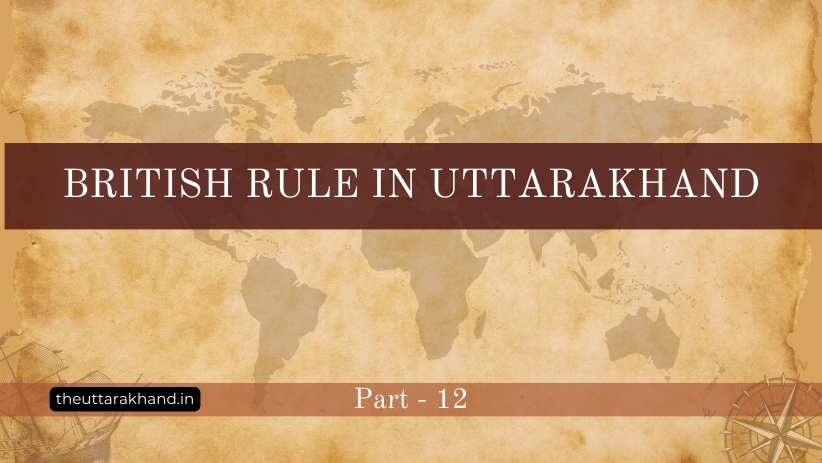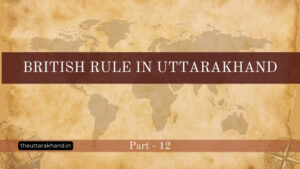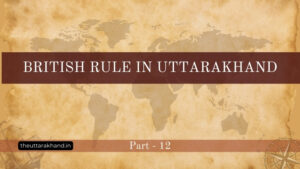British Rule in Uttarakhand

British Rule
Table of contents
- I. Introduction to British Rule in Uttarakhand
- Abolition of Wife-Swapping Practice (Kupratha) in Uttarakhand (1817)
- Creation of the Position of Patwari (1819)
- VII. Establishment of the District Court System in Dehradun (1830):
- VIII. Introduction of Stamp Duty Fees for Court Cases (1820):
- IX. Discovery of the Tehri Garhwal Treasure (1834):
- XI. Appointment of Colonel Govan as Commissioner (1836-1838)
I. Introduction to British Rule in Uttarakhand
British Rule in Uttarakhand : Uttarakhand, a state located in northern India, has a rich and complex history that predates the arrival of the British Empire in the early 19th century. However, it was during the British colonial era that many significant developments took place in the region, shaping its political, social, and economic landscape. This article will explore some of these milestones, focusing specifically on three important events: the establishment of postal services in Uttarakhand (1816), the construction of jails in Almora and Paudi (1816 and 1821), and the subsequent impact they had on the local population. By examining these events in detail, we can gain a better understanding of how British rule influenced the development of Uttarakhand and left a lasting legacy that continues to shape the region today.
Establishment of Postal Services in Uttarakhand (1816)
British Rule in Uttarakhand : One of the earliest indications of the British presence in Uttarakhand came in the form of postal services. Prior to the arrival of the British, communication between different parts of the region was limited, relying primarily on messengers on horseback or foot. With the expansion of the East India Company’s territories, however, the need for efficient communication networks became increasingly apparent. Thus, in 1816, the first official post office was established in the town of Landour, near Mussoorie.
This marked the beginning of a long tradition of postal services in Uttarakhand, which would eventually become an integral part of daily life in the region. Over the years, additional post offices were opened throughout the hills, connecting remote villages to larger towns and cities. These post offices not only facilitated communication but also played a crucial role in the administration of the region, serving as hubs for revenue collection, census taking, and public announcements.
For the people of Uttarakhand, the advent of postal services brought numerous benefits. Letters and parcels could now be sent across vast distances at relatively low cost, allowing families separated by mountainous terrain to maintain contact. Moreover, access to news and information from outside the region helped to broaden horizons and foster a sense of connection to the wider world. As literacy rates improved, the demand for postal services grew, leading to further expansion and modernization of the network.
Today, Uttarakhand boasts a robust postal service infrastructure, with over 3,000 post offices spread across the state. While technology has undoubtedly changed the nature of communication, the importance of postal services remains undiminished, providing vital links between communities and enabling the exchange of ideas, goods, and services.
Construction of Jails in Almora and Pauri (1816 and 1821)
Another critical aspect of British rule in Uttarakhand was the establishment of a formal justice system. Before the arrival of the British, disputes were typically resolved through traditional village councils known as panchayats. However, with the extension of British authority into the region, new institutions were required to enforce law and order. To this end, two major prisons were constructed – one in Almora (1816) and another in Pauri (1821).
These jails served several purposes. Firstly, they provided a means of incarcerating individuals who had committed crimes, thereby deterring potential offenders and maintaining social order. Secondly, they functioned as symbols of British power and control, reinforcing the idea that the East India Company was the ultimate arbiter of justice in the region. Finally, they served as centers for the implementation of new laws and regulations, helping to transform Uttarakhand into a more centralized and bureaucratic entity.
However, the construction of these jails also had profound implications for the local population. Many indigenous practices and customs came under scrutiny as the British sought to impose their own values and norms. Furthermore, the criminalization of certain activities, such as cattle theft or alcohol production, led to increased tensions between authorities and rural communities. Over time, these conflicts would give rise to widespread resistance movements, culminating in the famous Chipko Andolan (Hug the Trees Movement) of the 1970s.
Despite these challenges, the jails built in Almora and Pauri continue to serve their intended purpose, albeit in a somewhat modified form. Today, they stand as reminders of Uttarakhand’s complex past, embodying both the positive and negative aspects of British influence. As such, they remain important sites for reflection and dialogue, shedding light on the ongoing struggle to balance tradition and progress in the region.
Abolition of Wife-Swapping Practice (Kupratha) in Uttarakhand (1817)
Introduction:
The year 1817 marks a significant milestone in the history of Uttarakhand, as it saw the abolition of a deeply ingrained custom called ‘kupratha’, which involved the swapping of wives among men within a community. This antiquated practice, prevalent in the hilly regions of present-day Uttarakhand, had been passed down through generations and formed an intrinsic part of the local culture. However, the arrival of the British Raj heralded a transformation in societal norms and values, resulting in the eventual eradication of this controversial ritual.
Background:
Before delving into the reasons behind the abolition of kupratha, it is necessary to understand the context in which this practice emerged and thrived. The geographical isolation of Uttarakhand’s mountainous terrain contributed to the evolution of unique customs and traditions, often distinct from those practiced elsewhere in India. Kupratha was one such tradition, believed to have originated from the belief that sharing resources, including women, strengthened communal bonds and fostered harmony amongst villagers.
Reasons for Abolition:
Several factors coalesced to bring about the demise of kupratha. Foremost among them was the intervention of the British East India Company, which viewed the practice as immoral and degrading. Upon learning about kupratha, officers of the Company expressed outrage and vowed to put an end to it. Their stance was bolstered by humanitarian concerns regarding the welfare of women forced into unwanted unions, as well as broader moral objections rooted in Victorian sensibilities.
Additionally, the British perceived kupratha as a hindrance to establishing their authority in the region. Colonial administrators believed that eradicating this practice would facilitate the imposition of their governance structures, making it easier to administer justice and collect taxes. Consequently, efforts were initiated to convince locals of the merits of abandoning kupratha.
Missionaries accompanying the British military force also played a crucial role in advocating against kupratha. They argued that Christianity emphasized monogamy and fidelity, concepts deemed incompatible with the notion of shared matrimony promoted by kupratha. Missionary activity thus gained momentum alongside attempts to dissuade locals from engaging in this age-old practice.
Impact of Abolition:
Following its prohibition, kupratha began to fade away gradually. Women previously subjected to involuntary spouse-sharing experienced greater autonomy over their personal relationships and sexual partners, while men faced fewer constraints when choosing romantic companions. Despite initial resistance from conservative elements within society, the gradual acceptance of monogamous marriage patterns allowed for more stable family units and reduced instances of domestic violence.
Moreover, the ban on kupratha enabled the emergence of individual identities separate from collective ones defined by caste and kinship ties. Greater emphasis on personal choice empowered individuals to pursue careers, education, and aspirations beyond the confines of their immediate surroundings. Ultimately, these changes laid the groundwork for a more progressive and inclusive society in Uttarakhand.
Creation of the Position of Patwari (1819)
Introduction:
British Rule in Uttarakhand : As the British consolidated their hold over Uttarakhand following the Anglo-Nepalese War of 1814-1816, the need for effective land management systems became evident. Recognizing the necessity of creating a cadre of officials tasked with managing revenue collection, record keeping, and dispute resolution, the British introduced the position of patwari in 1819. This move revolutionized land governance in Uttarakhand, ushering in a new era characterized by standardization and accountability.
Role of Patwaris:
Patwaris were entrusted with a variety of responsibilities aimed at streamlining land administration processes. Key duties included maintaining accurate records of agricultural lands, assessing crop yields, calculating tax liabilities, and settling disputes relating to property ownership or boundaries. Essentially acting as intermediaries between the government and local populace, patwaris wielded considerable influence within their jurisdictional areas.
To ensure efficiency and transparency, stringent selection criteria were imposed on prospective candidates. Applicants were required to possess sound knowledge of regional languages, cultures, and customs, along with basic numeracy skills. Once appointed, patwaris underwent rigorous training programs designed to equip them with requisite expertise in matters pertaining to land governance.
Implications of Patwari System:
The creation of the patwari system significantly altered land management practices in Uttarakhand. Standardized procedures replaced ad hoc methods, reducing ambiguity surrounding tenure rights and tax obligations. Improved documentation allowed for more equitable distribution of resources, benefiting smallholder farmers and marginalized groups who had historically struggled to assert their claims.
Furthermore, the institution of patwaris fostered trust between the British administration and local communities. By employing locals familiar with regional nuances, the British demonstrated a willingness to engage with rather than alienate the very people they sought to govern. This approach proved instrumental in minimizing friction and promoting stability amidst rapid socio-political transitions.
Green Committee Set Up by Commissioner Traill (1822)
Introduction:
British Rule in Uttarakhand : Commissioner George William Trail’s tenure in Uttarakhand witnessed multiple initiatives aimed at improving living conditions and enhancing productivity. Among these endeavors, the establishment of the Green Committee stands out as particularly noteworthy due to its far-reaching impacts on agriculture, forestry, and environmental conservation.
Objectives of the Green Committee:
Formally constituted in 1822, the Green Committee comprised senior British officials and Indian experts tasked with addressing pressing issues related to resource utilization and sustainability. Specific objectives included:
- Encouraging scientific farming techniques to boost agricultural output;
- Promoting afforestation and reforestation efforts to combat soil erosion and restore degraded landscapes;
- Introducing measures to protect wildlife habitats and regulate hunting activities;
- Fostering collaboration between government agencies, research institutes, and local communities to optimize resource management strategies.
Outcomes of Green Committee Initiatives:
Under the guidance of the Green Committee, several innovative schemes were launched, yielding tangible benefits for both the environment and economy. Some prominent outcomes include:
- Introduction of high-yielding crop varieties, irrigation facilities, and fertilizers to enhance farm productivity;
- Development of agroforestry models integrating trees, crops, and livestock to maximize land usage efficiency;
- Implementation of soil and water conservation measures such as terracing, gully plugging, and contour bunding;
- Strict penalties for illegal logging, poaching, and encroachment upon protected areas;
- Establishment of botanic gardens, nurseries, and experimental stations to propagate native species and test novel cultivation technologies.
These interventions catalyzed a shift toward sustainable development paradigms, setting precedents for future policymaking in Uttarakhand. More importantly, they underscored the significance of holistic approaches encompassing ecological, social, and economic dimensions in achieving long-term prosperity and resilience.
VII. Establishment of the District Court System in Dehradun (1830):
Introduction:
Dehradun, nestled in the Doon Valley, serves as the capital city of the modern-day state of Uttarakhand in India. Its strategic location made it an ideal spot for the British to establish their administrative center during their rule in the country. One of the most significant contributions of the British regime in Dehradun was the establishment of the district court system in 1830, which played a pivotal role in dispensing justice and maintaining law and order in the region.
Background:
Before the establishment of the district court system, the judicial process in Dehradun followed the traditional method of using village elders and chiefs to resolve disputes. The lack of a structured system resulted in inconsistent judgments and unequal application of rules. When the British acquired the territory in the early 19th century, they realized the urgent need for a proper judiciary to ensure smooth functioning of the civil and criminal administration.
Establishment of the District Court System:
The British established the district court system in Dehradun in 1830, appointing the first Civil Judge & Magistrate, Mr. H.D. Robertson. Under his leadership, the court handled various types of cases, including civil suits, criminal proceedings, and appeals. The structure of the court consisted of a single judge presiding over hearings and delivering verdicts based on evidence presented before him.
Initially, the district court operated in temporary premises until 1833 when the British erected a permanent building called the Old Secretariat Building to house the courtroom and supporting staff. This building still exists and functions as a courthouse today.
Impacts of the District Court System:
The establishment of the district court system in Dehradun brought about a significant change in the judicial process. It ensured consistent judgment delivery, fair trial, and equal treatment under the law for all citizens. The systematic approach adopted by the British courts eliminated any biased decision-making common in traditional forms of justice.
Additionally, the district court system offered opportunities for career advancement for Indians interested in pursuing a legal profession. Locals trained in English law filled positions as pleaders, vakils, and munsifs, contributing positively to the growth of the middle class in Dehradun.
VIII. Introduction of Stamp Duty Fees for Court Cases (1820):
Introduction:
British Rule in Uttarakhand : Stamps have always held immense value in societies around the globe. During the British Raj, stamps evolved beyond mere markers of authenticity to assume financial significance in various domains, including court proceedings. An act introduced in 1820 mandated the payment of stamp duty fees for court cases filed in British India.
Background:
The concept of stamp duty dates back to ancient times, where seals and impressions symbolized legitimacy and authentication. During the British Rule, stamp duty emerged as a primary source of revenue generation for the colonial government. In 1820, the British Parliament passed Act No. IV, titled “An Act for Granting Certain Privileges to the East India Company,” introducing stamp duty fees on various documents used in court cases.
Implementation of Stamp Duty Fees:
The implementation of stamp duty fees for court cases entailed attaching a prescribed fee to every document submitted to the court. Such charges varied according to the type of case, its complexity, and the number of pages involved. Revenue generated from these fees funded the salaries of judges, clerks, and support staff working within the judicial framework.
Significance of Stamp Duty Fees:
Introducing stamp duty fees for court cases brought uniformity to the judicial procedure by eliminating arbitrary pricing mechanisms prevalent earlier. The fixed tariffs associated with specific documents prevented exploitation and encouraged litigants to seek redressal without fear of exorbitant costs.
Moreover, stamp duty fees played a crucial role in augmenting government revenues, financing infrastructure projects, and funding social initiatives. Over time, this influx of funds supported the expansion of the judicial system, leading to improvements in overall legal services accessible to the general public.
IX. Discovery of the Tehri Garhwal Treasure (1834):
Introduction:
British Rule in Uttarakhand : Discoveries of hidden treasures never fail to fascinate historians and laypeople alike. Amidst stories of buried riches lies the tale of the Tehri Garhwal treasure discovered in 1834, revealing fascinating insights into the opulence and grandeur of erstwhile rulers in what is now modern-day Uttarakhand.
Background:
Tehri Garhwal, situated northwest of present-day Dehradun, once flourished as a powerful kingdom ruled by the Shah dynasty. Following centuries of accumulation, the royal household amassed substantial wealth stored securely within fortified vaults scattered across their sprawling estates. After losing control of large portions of their domain to the expanding British empire, the last reigning king, Sudarshan Shah, decided to conceal the remaining fortune to prevent plundering by foreign invaders.
Discovery of the Tehri Garhwal Treasure:
In 1834, a group of British explorers stumbled upon secret underground chambers containing precious metals, gemstones, coins, jewelry, and ceremonial artifacts estimated to be worth millions of pounds sterling. Word soon reached the British authorities, who seized the hoard and transported it to England, intending to auction off the items and utilize the proceeds to finance various projects in India.
Impact of the Discovery:
The discovery of the Tehri Garhwal treasure triggered intense curiosity worldwide, drawing attention to the extravagant lifestyles enjoyed by ruling classes during precolonial India. News reports detailed elaborate descriptions of gold coins bearing portraits of Hindu gods, diamond necklaces fit for queens, and rare ivory figurines depicting mythical creatures.
While much of the loot vanished into private collections or museum exhibitions abroad, traces of the original trove remain preserved in select locations like the Victoria Memorial Hall in Kolkata and the British Museum in London. Nonetheless, questions persist concerning the rightful owners of these stolen treasures and whether adequate compensation should be granted to descendants of the former rulers.
X. Formation of the Halduvanie Khas Estate (1834)
Introduction
The Halduvanie Khas estate, established in 1834, marked yet another significant milestone in the evolving history of Uttarakhand during the British colonial era. This newly created estate encompassed a vast expanse of land stretching from the western boundary of the Almora district to the eastern limits of the Dehradun district. Spread over approximately 1,000 square miles, the Halduvanie Khas estate was home to diverse ethnic groups, topographies, and natural resources, rendering it a microcosm of Uttarakhand itself.
Formation of the Halduvanie Khas Estate
The origins of the Halduvanie Khas estate can be traced back to the mid-1830s when the British administration embarked on a comprehensive survey of the entire region. The objective was to categorize and quantify the available land resources, ascertain their productive capacity, and devise a rational system for revenue collection. During this extensive exercise, the British identified a sizeable tract of land characterized by its distinctive features, prompting them to carve out a separate estate dubbed the Halduvanie Khas estate.
Key Features of the Halduvanie Khas Estate
- Demarcation: The Halduvanie Khas estate was demarcated from neighboring estates and districts through clearly defined borders, ensuring that overlapping jurisdictions did not create confusion or conflicts.
- Administration: The estate was placed under the direct supervision of a Deputy Commissioner, who reported directly to the Commissioner of Kumaon division. This hierarchical arrangement facilitated efficient administration and expedited decision-making processes.
- Land Use Patterns: The Halduvanie Khas estate featured diverse land use patterns, ranging from fertile agricultural fields to dense forests, barren wastelands, and river valleys teeming with fish. Each category of land was assigned a specific revenue rate commensurate with its productivity and utility.
- Settlement Patterns: The inhabitants of the Halduvanie Khas estate predominantly belonged to hill tribes, such as Boksa, Tharu, Buksa, and Bahun, among others. These communities resided in compact settlements dotting the landscape, practicing subsistence agriculture and supplementing their income through seasonal wage labor.
- Natural Resources: The Halduvanie Khas estate abounded in valuable natural resources, including timber, medicinal plants, minerals, and water sources. The British recognized the commercial potential of these assets and instituted regulatory measures to govern their exploitation and trade.
Economic Significance of the Halduvanie Khas Estate
The Halduvanie Khas estate held immense economic significance for the burgeoning British imperial project in India. Several key industries drove the region’s economic engine, generating revenue and employment opportunities for both the colonial administration and local populace.
- Agriculture: The fertile valleys within the Halduvanie Khas estate lent themselves to the cultivation of cash crops such as rice, wheat, barley, maize, pulses, oilseeds, and sugarcane. These crops fetched handsome prices in nearby markets, providing a steady source of income for thousands of smallholding peasants.
- Forest Produce: Rich reserves of timber populated the expansive forests blanketing the Halduvanie Khas estate, offering lucrative prospects for extracting and marketing prized wood species like Sal, Deodar, and Oak. These woods found applications in shipbuilding, railway sleepers, furniture manufacture, and construction, fetching premium prices in international markets.
- Mineral Extraction: The Halduvanie Khas estate housed abundant mineral deposits, notably limestone, slate, marble, and copper ore. Quarrying operations commenced in earnest, supplying raw materials for cement factories, roofing tiles, sculptures, and metal smelters.
XI. Appointment of Colonel Govan as Commissioner (1836-1838)
Introduction
Colonel James Govan’s tenure as Commissioner of Kumaon Division from 1836 to 1838 coincided with a critical juncture in Uttarakhand’s history. His astute leadership navigated the region through tumultuous waters, steering clear of potential pitfalls while simultaneously laying the groundwork for future progress.
Appointment of Colonel Govan
Colonel James Govan assumed charge as Commissioner of Kumaon Division in 1836 after distinguished military service in various capacities across the vast expanse of the British Empire. His proven track record as an able administrator and strategic thinker earned him the coveted posting, wherein he oversaw the affairs of several districts, including Nainital, Almora, Garhwal, and Kumaon.
Key Contributions of Colonel Govan
- Consolidation of Administrative Structures: During his tenure, Colonel Govan focused on strengthening existing administrative structures, refining revenue collection mechanisms, and streamlining judicial processes. He championed the cause of impartiality and equity, eschewing favoritism and nepotism, earning him respect and admiration from both his peers and subordinates.
- Infrastructure Development: Recognizing the need for reliable transportation networks, Colonel Govan invested heavily in road construction linking distant hamlets to bustling marketplaces. These roads facilitated commerce, enhanced security, and fostered social integration among diverse communities inhabiting the rugged terrain of Uttarakhand.
- Education Reforms: Colonel Govan advocated passionately for universal education, believing that an educated populace served as the bedrock of a strong and prosperous nation. He promulgated policies encouraging school attendance, teacher training, and curriculum development, leaving an indelible mark on Uttarakhand’s educational landscape.
XII. Conclusion to British Rule in Uttarakhand
British Rule in Uttarakhand : The halcyon days of the Halduvanie Khas estate and the sagacious leadership of Colonel Govan exemplify the myriad facets of Uttarakhand’s storied past. The formation of the estate reflected the British administration’s keen interest in cataloging and harnessing the region’s untapped potential, while Colonel Govan’s stewardship embodied the virtues of good governance, visionary planning, and steadfast commitment to uplifting the masses.
As we traverse the annals of history, it becomes evident that Uttarakhand’s journey has been punctuated by momentous occasions, seminal figures, and transformative ideologies. The region’s chequered past bears testimony to the trials and tribulations encountered along the path to self-discovery, illustrating the resilience and determination of its people in surmounting adversity.
British Rule, In retrospect, the experiences gleaned from yesteryears offer valuable lessons for contemporary society, guiding us towards a harmonious coexistence anchored in mutual respect, tolerance, and inclusivity. As custodians of this rich heritage, let us endeavor to cherish and celebrate our collective memories, preserving them for posterity, lest they fade into oblivion. For it is through remembrance that we truly honor the sacrifices and achievements of those who walked before us, illuminating the way forward.





